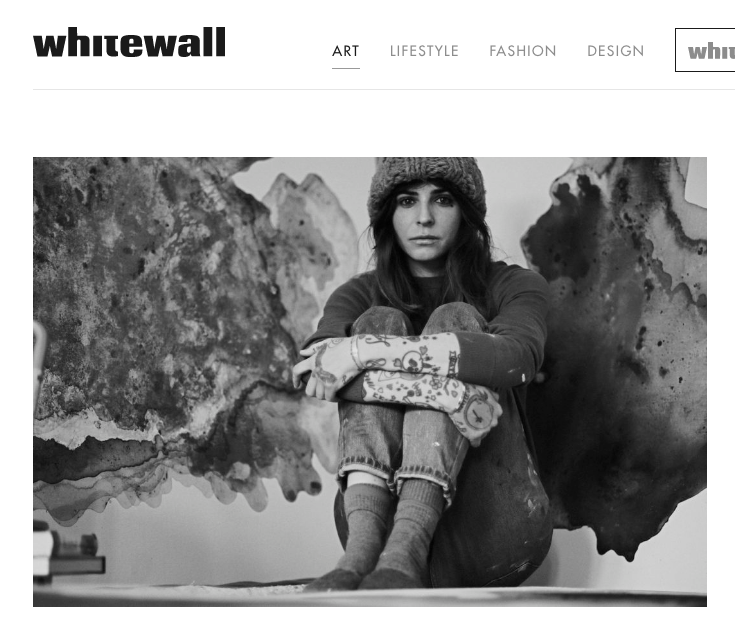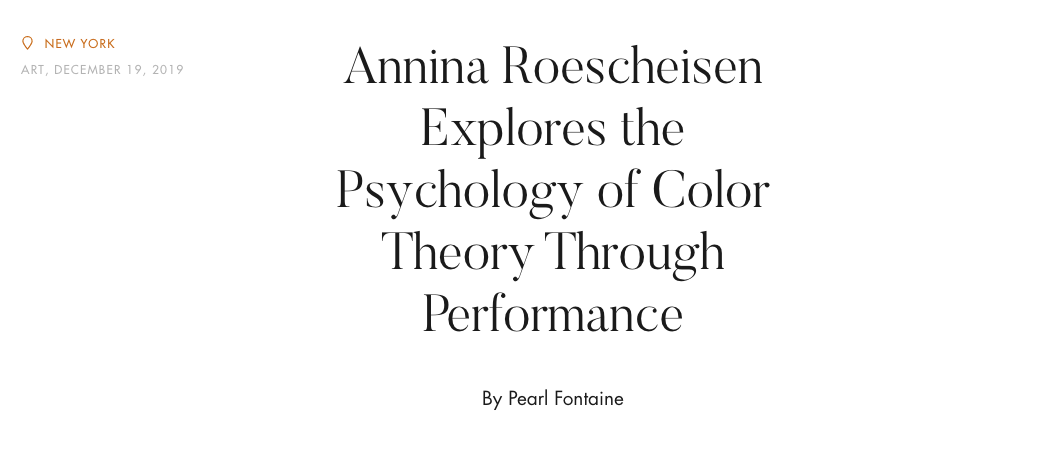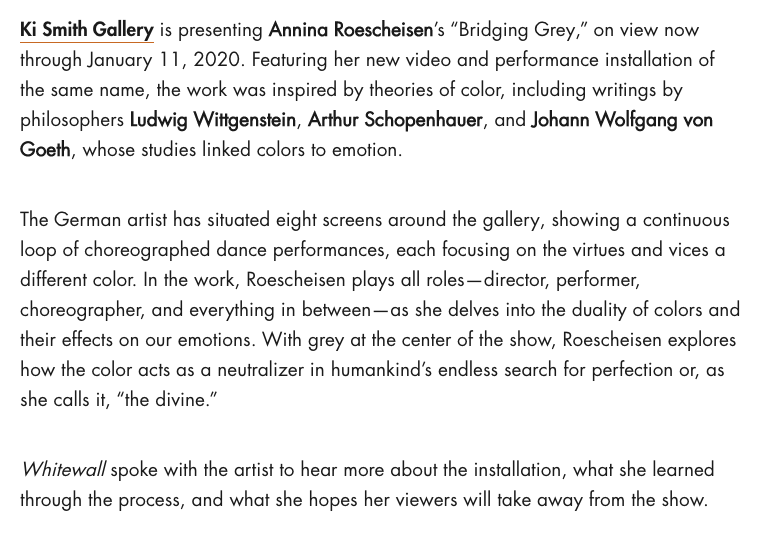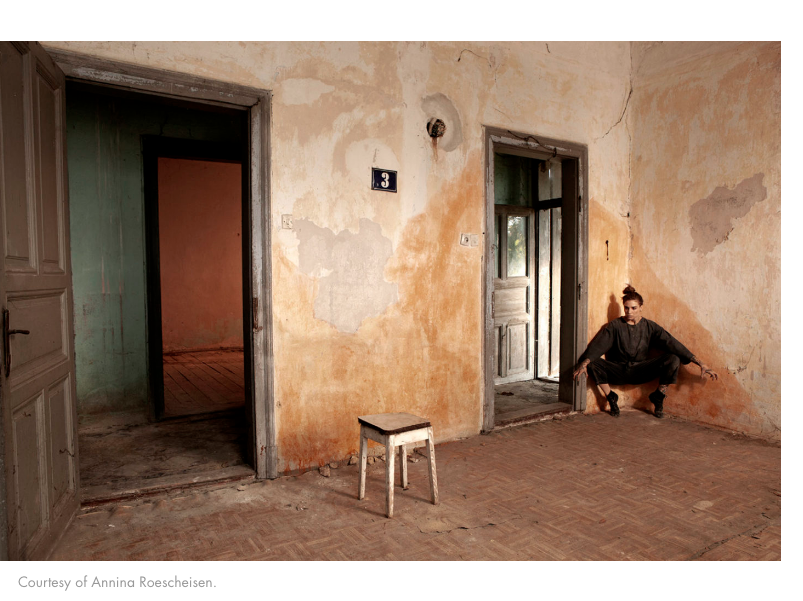WHITEWALL Magazine INTERVIEW on “BRIDGING GREY” Solo Exhibition NY 2019/2020
WHITEWALL: Your work Bridging Grey is inspired largely by Johann Wolfgang von Goethe’s Theory of Colours and similar writings by Ludwig Wittgenstein and Arthur Schopenhauer, correct? Tell us about your starting point and how the work unfolded.
ANNA ROESCHEISEN: We often consider color in a very natural, subconscious way without thinking of the effect that color has on our emotional, rational, or spiritual body. Where Schopenhauer and Wittgenstein shed light on this topic in a more theoretical and physical way, Goethe dared to investigate color further, in a new realm: he observed the effect of color on our emotions in subjective experiments and discovered how it affects us—stimulates us or even aggravates us.
“Bridging Grey” seeks to combine the metaphor of the rainbow with the theory of colors. I wanted to re-create a sort of bridge between us—the humans—and the divine that emphasizes our human boundaries and gives an artistic explanation of why we can’t walk that bridge to fully becoming divine—even though we all strive for perfection and therefore seek a certain divinity.
I dissected the seven colors of the rainbow in a performative way, distilling each to its virtue and vice. I am not only pointing out a duality of behavior, but also underlining that within every color there is duality in both meaning and effect. Red, for example, symbolizes love and birth as much as it represents hate.
The apotheosis of “Bridging Grey” is artistically bridged by the color grey, which Goethe explains is the tamest color and lacks almost any emotion. If you continue to mix colors on and on, at a certain point you will always end up with a grey, muddy tone. I, however, use grey as a neutralizer, as well as a balance zone that we humans try to find within ourselves. I consider it a moment of peace and balance.
 Courtesy of Annina Roescheisen.
Courtesy of Annina Roescheisen.WW: You’ve said, “We often understand color as a unity, we don’t tend to divide the rainbow into its components.” In the exhibition, you’ve done just that—study each color individually. By doing so, what did you discover?
AR: By separating the colors and observing them one by one, I became more conscious about each color’s inhabited duality. We tend to forget that every color has a dark as well a light side. We, for instance, do not only associate blue with the sky and light but also with the soul and introspection. The blue of the ocean is associated with beauty while its infinite depth provokes our inner fears, like a dark abyss.
WW: The dualities of emotions and meanings associated with different colors brings into question the distinctive, binary paths of right and wrong that have been drilled into our brains since childhood. What kind of narrative were you hoping to create on this topic throughout the installation?
AR: I was hoping to raise awareness on our patterns of thinking and how we are all formed by society to understand and separate the world into right and wrong, black and white.
I don’t really think we can escape this formation (almost castration), but I do think by accepting it we slowly escape the judgmental part of it. We no longer feel as controlled as we begin to see the whole picture more clearly. We’re free to decide if we want to act within the box or broaden our vision to see things and feel things in a new way.
My wish is not to eradicate dualism. This would be impossible. “Bridging Grey” hopefully frees us a step further in our search for who we really are.
 Courtesy of Annina Roescheisen.
Courtesy of Annina Roescheisen.WW: In the work, you intended grey to act as a balancing point between the extremes of our world. How does this connect the earthly viewer with the world of the divine?
AR: Grey is used as an anchor in “Bridging Grey.” Our cities are grey, we often call people grey, and, unfortunately, we often associate grey with something negative. I think of it as a mixture of all our colors and emotions. I don’t think we can reach the world of the divine. But in my eyes, we search for a divinity association that I like to translate here simply as peace. We tend to liken the divine to something soothing and calm, something peace-bringing. So, in my eyes, it’s a possible path towards divinity.
I hope that through experiencing “Bridging Grey” the viewer might start observing his emotions in relationship to colors, looking beyond the artistic realm and freeing himself from his limiting and judgmental thoughts.
WW: Has your perception of color in your daily life and artistic practice changed since the creation of “Bridging Grey”?
AR: It definitely has. My awareness of color perception and how it affects us increased. It’s present everywhere and in all fields. I’ve started to think differently about, for example, advertising and how their use of colors manipulates us. The moment you gain that awareness, you truly free yourself from the impact that an advertiser wants to lay on you.
Another example: it made me aware of how I can find somebody disturbing because of the color of his sweater. Perhaps it aggravates me. Maybe I love a work of art more than another one because of its color. Again, the closer I get to understanding emotions in the context of color, the more liberated I feel.
It’s a mind and emotion game worth playing. It’s very exciting to become more self-reflective, to make sense of my surroundings, and to abandon strict judgements through the exploration of color.




